If you haven’t heard about hunting in New Zealand by now, you must have been living under a rock somewhere. But amidst all the hype and debates about high-fence, DIY vs guided and everything in between you’ve likely been left with more questions than answers. If you’re a serious, free-range mountain and wilderness hunter like me, NZ can be a confusing place to suss out. In this debut Destinations article I hope to give you some insight into the mountain species to focus on, the different areas available to hunt and how to decide what type of hunt to pursue if you intend to make the trip to what many consider one of the best mountain hunting destinations in the world.
First off a little about myself. I grew up on a sheep and beef farm on the rural South Island of New Zealand hunting feral goats, pigs and Red deer. By the time I was 16, I had progressed to Tahr and Chamois hunting and guiding under my Uncle’s tuition. I now run a small outfit focused on free range wilderness hunts in the South Island and have spent two seasons working as a Glacier Guide on the West Coast of NZ, two seasons guiding in BC Canada (Sheep, Mountain Goats and Moose) and have hunted in Colorado for Elk, so I have a decent understanding of what hunters expect in terms of mountain hunting.
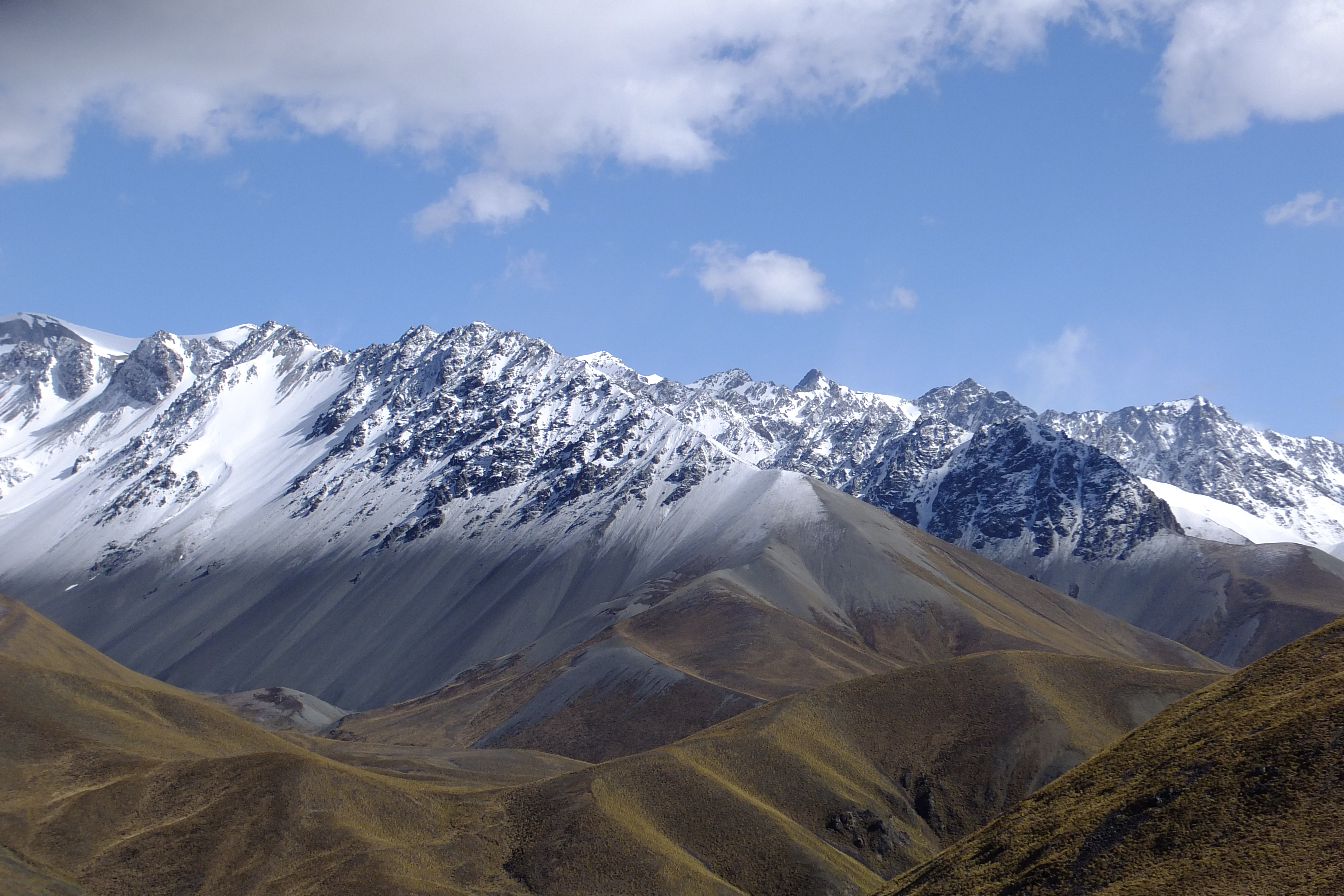
The main three species that most international hunters travel here to chase are Red Stag, Tahr and Chamois. We also have Sika, Sambar, Rusa, Wapiti, Whitetail and Fallow deer species in pockets throughout the country. Wild pigs, Goats and Sheep can also be hunted as well as Wallabies, Hares, Possums and Rabbits for small game. We also have waterfowl and upland bird hunting and very good fisheries for both Rainbow and Brown trout. New Zealand has truly some of the best hunting and fishing the world can offer. I plan to cover our three main species with a little information about where and when to hunt them.
New Zealand is a small multicultural Island nation in the South Pacific. New Zealanders (Kiwis) are generally very friendly and relaxed, we enjoy a large variety or outdoor pursuits, hunting and fishing among the most popular. New Zealand has very unique native flora and fauna with no native land mammals (apart from some bat species). During the late 1800s and early 1900s, thanks to the work of acclimatisation societies and T.E. Donne (Manager of Tourism at the time) many exotic species were introduced to establish the “sportsman’s paradise” we have today. Most of the species introduced have flourished and produce some of the best trophies in the world, due to lack of competition, zero predation and relatively mild winters. Over the last 100 years our game animals have faced government culling operations (foot and helicopter), commercial hunting (meat and skins), poisoning operations and general mismanagement and overhunting.
In recent years we have been seeing some changes in what has been classed as ‘noxious pests.’ Our animals are slowly gaining respect from the government and are now classed as ‘Game Animals’. The average NZ hunter is starting to change their views, as well, letting our animals once again reach their full genetic potential. The trophies that have come off public land in the last couple of years are truly impressive and NOW is the best time in the last 50-60 years for good quality free range hunting in New Zealand.
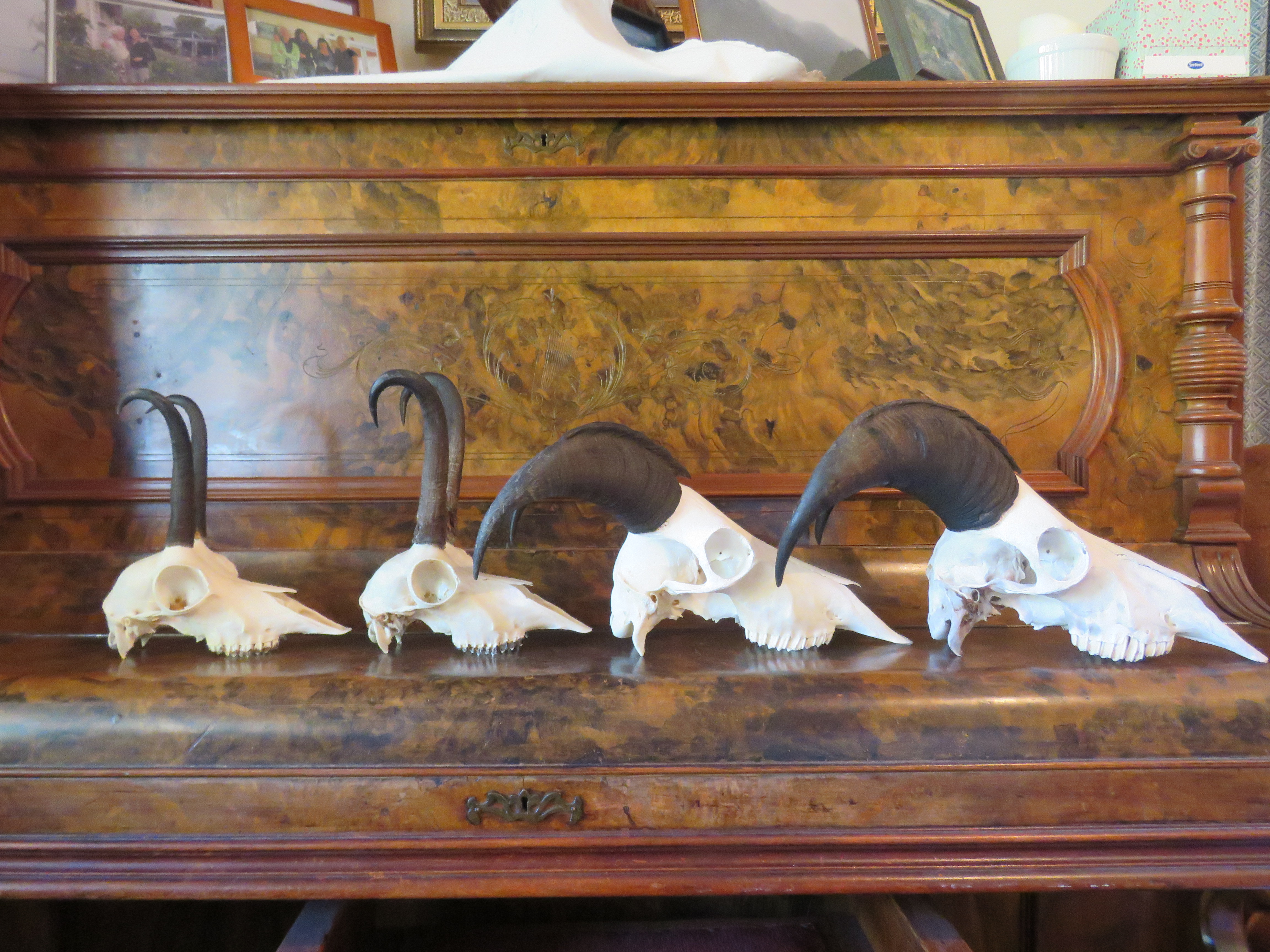
The Alpine Double
Himalayan Tahr and Alpine Chamois (Chammy or more correctly Cham mwa or Gemse), form the “Alpine Double”. These are our two true Alpine species, Chamois from Austrian stock were released in 1907 as a gift from Emperor Franz Josef. Tahr were released in 1904 from an English Game Park, most likely originally British Indian stock. Both were released near Mt. Cook, our highest mountain, and expanded rapidly throughout the Southern Alps. Hunting these animals is much the same as other mountain hunts for Goats or Sheep. Expect lots of glassing, steep climbs and, with a bit of luck, a trophy of a life time. We have a mild maritime climate and our tree line is around 1,000m, or 3,000 feet, for most of the country, and most of the hunting for these species is conducted at or above this altitude, above 2,000m, or 6,000 feet, there is normally permanent snow and ice with little vegetation.
Himalayan Tahr
Hemitragus jemlahicus, the Himalayan Tahr is a true mountain animal from the highlands of Nepal and India. A mature Bull Tahr is a truly impressive animal, similar in size and stature to a Mountain Goat, short stocky and muscular, throughout the colder months (May-August) they have an impressive mane used for display purposes during the rut. A Bull Tahr is 2-3 times the size of a nanny and this, combined with their mane, makes them look truly huge. Their range is currently limited to the main spine of the south island, the Southern Alps. The Department of Conservation limits their spread north and south by helicopter culling and keeps the total number of Tahr in NZ around 10,000 animals.

Alpine Chamois
Rupicapra rupicapra , the Alpine Chamois Native to the Alps of Europe, are a ‘goat antelope.’Lightly built and long legged a Chamois can be a funny looking critter. But what they lack in size they make up for in agility and speed in some of the most daunting terrain in the mountains. Usually weighing less than 100lbs (45kg), both Bucks and Does carry short, hooked horns. In the summer months, they are light tussock colour with a distinctive black dorsal and facial stripe. This changes to an almost black winter coat with white facial markings. Both colour phases are very attractive and make great mounts or flat skins. Chamois have a large and often times random distribution in the South Island. They are found in the Main Southern Alps and also in smaller outlying mountain ranges in pockets.
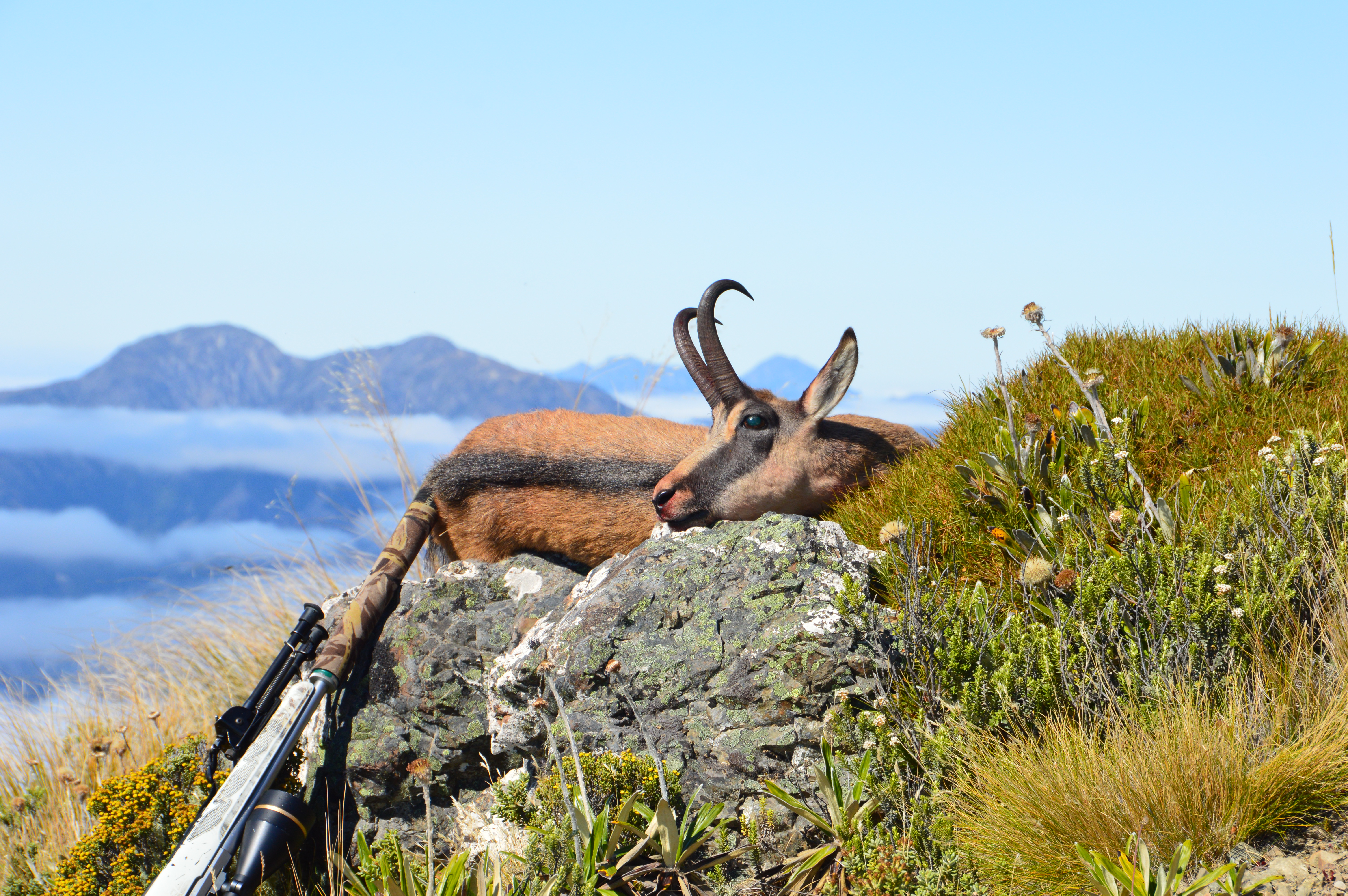
Public or Private Land?
If you are planning a trip to NZ most guides/outfitters will operate on private land, with a few operating on both Public and Private land. Private land generally has better animal numbers and hunting can be controlled somewhat to allow animals to mature. Nearly all private land for Tahr and Chamois hunting will be on the east coast of the South Island. These are usually large “stations” or farms, running a few beef cattle and sheep (often Merinos). These Stations will have 4×4 access to some degree and hunting is usually conducted from a “lodge” or a small mountain cabin/hut, where 4×4 is used to cover the ground and spot and stalk style hunts are conducted on foot. These hunts usually have a higher price tag than public land, as guides pay trophy fees for access to the stations.
Getting access to a good Tahr or Chamois spot can be quite difficult, as there is the potential for money to be made. This is usually the best option for older hunters or those that are new to mountain hunting, or those who are not overly fit. Hunts on private land normally take 3-5 days and normally run 100% success rate.
Public land is land that is managed by our Department of Conservation (DoC). There are huge areas of public land in both the North and South Island, and cover a wide variety of terrain types and species. Most of this land has un-restricted hunting all year around, most hunting is foot access with some areas having helicopter access, which is used for drop camp style hunting. Public land also receives hunting pressure from helicopters directly, DoC missions to cull Tahr and Chamois in certain areas, 1080 poison drops to control possums, commercial meat operators mainly after Red Deer and ‘AATH’ Or ‘Heli Hunts,’ guides after Tahr and Chamois for their clients.
Our Public land in New Zealand receives hunting pressure in ways most foreigners are not used to, but not all is bad. We have no predators here, relatively mild winters, our game animals breed very fast and are very resilient compared to US and European standards. The largest Tahr and Chamois trophies ever shot have been taken off public land (the current world record Tahr was shot in 2012 off Public land).
Hunting on public land can be tough, but is very rewarding. Currently, the game found on public land are at good numbers and the trophy potential is as good as it has ever been. This is a combination of factors, mainly education and change in ethos from the average Kiwi hunter, allowing animals to mature and not shooting the first thing you see. If you come here to hunt public land, you are competing with Kiwi hunters who are generally very hardy and think nothing of walking big miles for a weekend hunt, and with helicopters which at times can be very un-relenting in their quest to fill freezers or quotas.
Guides that operate on public land will generally use helicopters for access to a mountain campsite on the West Coast or use 4X4 or walk in access on the East coast. Hunting on public land is the real deal. Guides normally have very high success on public land (usually 90-100%), you just normally will work a little harder for your trophy. You will want 5-10 days for a public land hunt, allowing for weather is an important factor, much like a trip to Alaska.

East Coast or West Coast?
The ‘Main Divide’ Southern Alps splits the South Island into two very different habitats. To cover all the terrain and vegetation types of the south island would take a number of books, but we can split the main Tahr and Chamois habitat into two large and very different areas, The Eastern and Western Sides of the Alps.
The East Coast generally has large open valleys with braided river beds, the terrain is dominated by Tussock (large grasses) and Scree slopes with rocky outcrops. I have been told it is similar to the Brooks Range, but I have not been there yet to confirm this. The valley floors will usually have some Beech Forest and smaller vegetation. The East Coast is drier by NZ standards (around 600-1,200mm or 20-45 inches of annual rain in a lot of areas, more near the Divide, less near the Coast). The East Coast is the main farming area of the South Island and a lot of Tahr and Chamois areas are on private land. The public land on the East Coast receives a fair amount of hunting pressure, as this is where most people live, the main city being Christchurch. There are still reasonable numbers of Tahr on public land, but you often have to work hard for them. Chamois have been pushed out of most areas Tahr inhabit, so you normally have to move to a different location to hunt both. Chamois are found in both the main Southern Alps and some smaller outlying mountain ranges.
The Western Side of the Alps is a very narrow stretch of the Island that is sparsely populated, there is some private land here but by and large most of the mountainous area is public land and National Park. The West Coast is more similar to Coastal BC or Alaska in terms of terrain and vegetation. The valleys are narrow and steep, lower down there is a dense evergreen rain forest with vines and tree ferns, this changes into dense sub alpine ‘monkey scrub’ a mixture of alpine plants that grow into an almost impenetrable belt. Above this is some open tussock country, rocky outcrops, rock slabs, snow and glaciers. The west coast is rugged and tough and WET. A lot of areas receive 5-6metres (200 inches+) of rain on the coast, this can double as you approach higher elevations. It’s not unusual to get 8-10 inches of rain in one day. So it’s wet and steep, why would want to go there?
Because of the dense vegetation and harsh terrain, the Tahr and Chamois on this side of the island have a lot more places to hide, from both foot and helicopter hunters, allowing more animals to reach their potential. They also have very large amounts of food for maximal growth. Tahr and Chamois are also found in good numbers together, but this is no longer common on the East coast. Because of the effort required to get above tree line, a lot of hunters choose to take short helicopter flights to a basic camp site or DoC hut where often Tahr and Chamois can be hunted. When the weather is good, the West Coast is the best place in the world, with spectacular glaciers and mountains, deep forested valleys and majestic game to match.
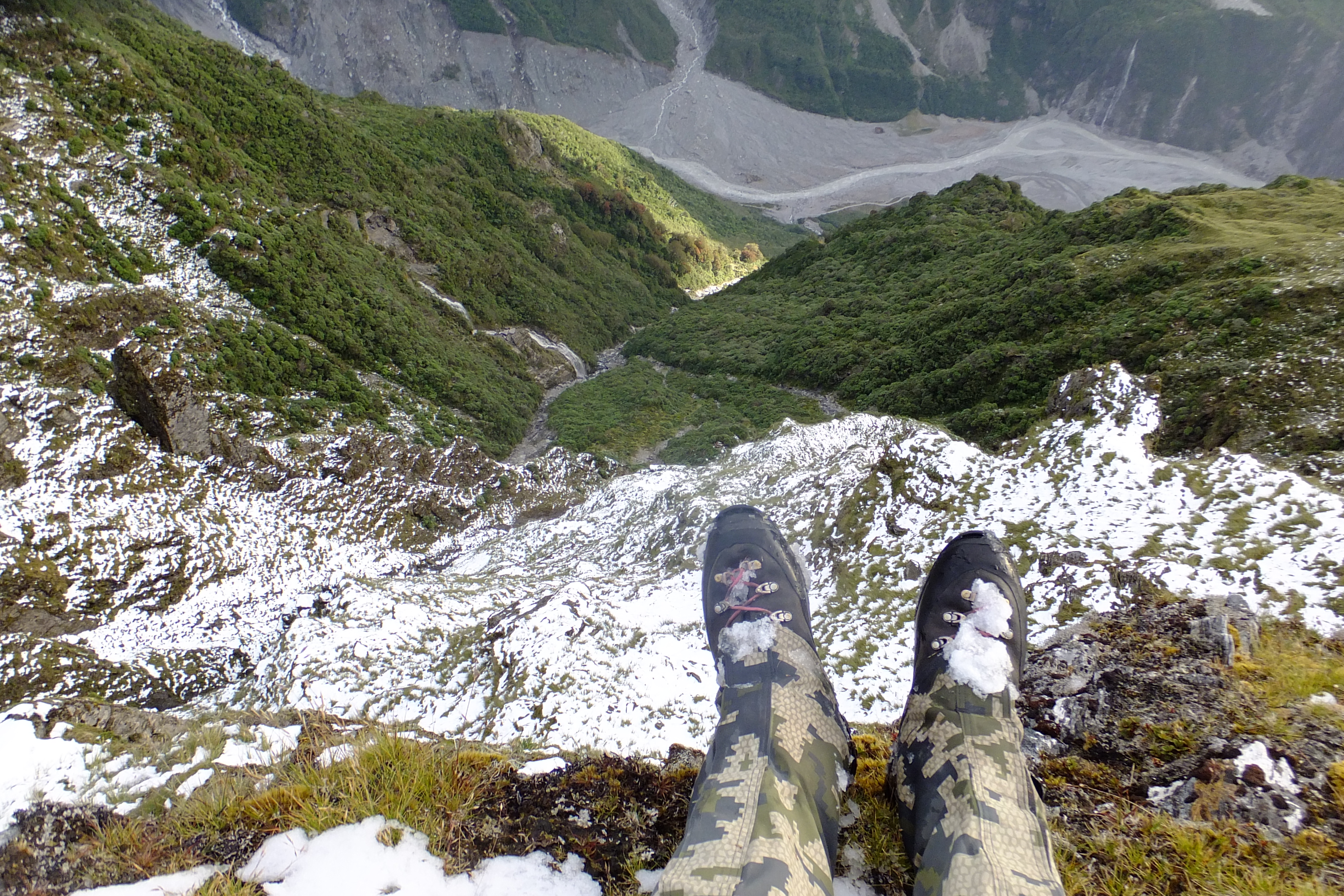
What Makes a Trophy?
Judging Tahr and Chamois like other goat and sheep species is an art in itself and both are very difficult to correctly age and size on the hoof.
For a mature Chamois buck, you are looking at horns in excess of 9 inches and bases around 3 ½ inches, and an exceptional buck will have horns in the 10 inch + class, much the same as Mtn Goats in terms of horn size. Old does are also sometimes taken as trophies and, like Mtn Goats, can have very long horns, usually losing a bit of mass and shape compared to a buck. Bucks should have a good hook to their horns and form and upside down J. Does usually have less hook and lighter mass. Like most animals Chamois grow the vast majority of their horns in the first 3-4 years. A good buck will normally be in the 6 year old+ age class. Ageing Chamois by horn annuli is near on impossible on the hoof, and often very difficult once you have the horns in your hand. In some areas they have very distinctive age rings and other areas they seem to be non-existent.
Bull Tahr are one of the hardest animals to judge correctly. Their small horn size relative to their body size and long hair can make it very changeling. You are looking for a mature bull at least six years old, with horns around the 12 inch mark. Some bulls will reach 12 inches at four years old, but they continue to grow in the body and hair length increases with age. A top trophy bull will be in excess of 13 inches and 10+ years old. On the west coast there are a number of bulls with broomed/broken horns, so you can take very old bulls with horns well under 12 inches. What they lose in horn they make up for with character, body mass and coat length.

What Time of Year?
For prime winter skins of both species, you want to plan for May-August. Our seasons are opposite to the Northern Hemisphere, the Tahr and Chamois rut is focused around late May and June. During the rut both species are a lot more active during the day which can make for some very exciting hunting. Late May-August you can expect snow and ice. Temps around -10C or colder at night and around 0 for the daytime.
Spring hunting (Sept-Nov) for Tahr can be very good. After the winter rut, Bulls are hungry and move to areas with good feed where they form bachelor mobs. There are longer daylight hours and better temperatures to camp out. Seeing a mob of 20+ mature bulls is a truly impressive sight and makes trophy evaluation easier. Tahr manes are bleached out and very blond at this time of year. Chamois hunting is fair but their skins are generally poor as they lose their winter coats.
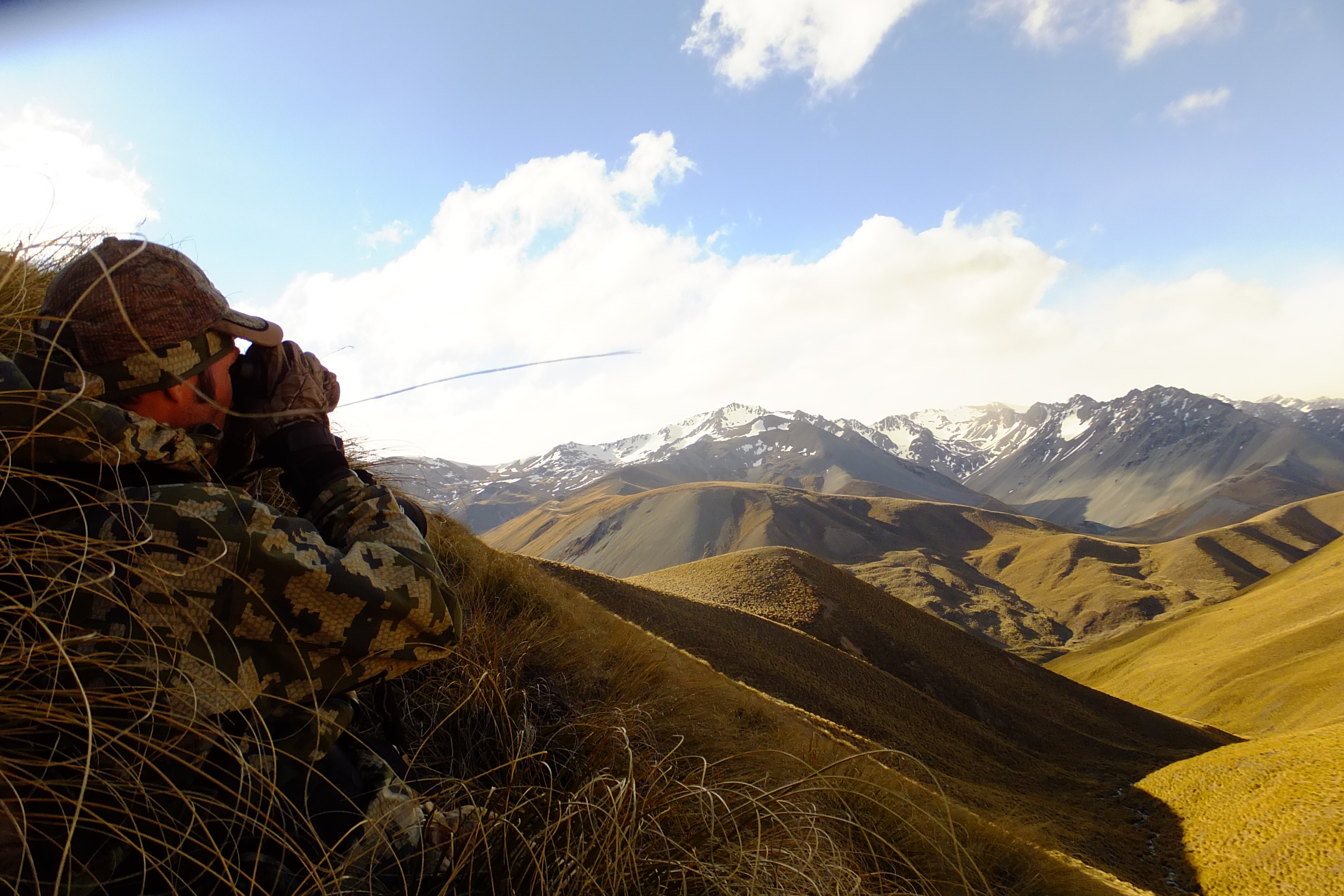
Summer can be a great time to get a nice Chamois buck in their attractive tussock skins. Tahr hunting is still good but the bulls lose their manes.
Well there it is, NZ Tahr and Chamois hunting in a nutshell. Next we will cover Red Stag and the other Deer Species of New Zealand. Hopefully this gives you some answers to what, how and where to focus your efforts if you’ve been dreaming of coming to “the bottom of the word” for an epic mountain hunt. One thing I can certainly promise you is it will an adventure you won’t soon forget!

